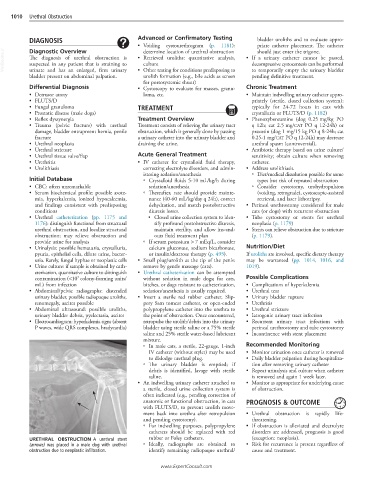Page 2018 - Cote clinical veterinary advisor dogs and cats 4th
P. 2018
1010 Urethral Obstruction
DIAGNOSIS Advanced or Confirmatory Testing bladder uroliths and to evaluate appro-
• Voiding cystourethrogram (p. 1181): priate catheter placement. The catheter
Diagnostic Overview
VetBooks.ir The diagnosis of urethral obstruction is • Retrieved uroliths: quantitative analysis, • If a urinary catheter cannot be passed,
determine location of urethral obstruction
should just enter the trigone.
suspected in any patient that is straining to
decompressive cystocentesis can be performed
culture
urinate and has an enlarged, firm urinary
urolith formation (e.g., bile acids as screen
bladder present on abdominal palpation. • Other testing for conditions predisposing to to temporarily empty the urinary bladder
pending definitive treatment.
for portosystemic shunt)
Differential Diagnosis • Cystoscopy to evaluate for masses, granu- Chronic Treatment
• Detrusor atony loma, etc. • Maintain indwelling urinary catheter appro-
• FLUTS/D priately (sterile, closed collection system):
• Fungal granuloma TREATMENT typically for 24-72 hours in cats with
• Prostatic disease (male dogs) crystalluria or FLUTS/D (p. 1182)
• Reflex dyssynergia Treatment Overview • Phenoxybenzamine (dog 0.25 mg/kg PO
• Trauma (pelvic fracture) with urethral Treatment consists of relieving the urinary tract q 12h; cat 2.5 mg/CAT PO q 12-24h) or
damage, bladder entrapment hernia, penile obstruction, which is generally done by passing prazosin (dog 1 mg/15 kg PO q 8-24h; cat
fracture a urinary catheter into the urinary bladder and 0.25-1 mg/CAT PO q 12-24h) may decrease
• Urethral neoplasia draining the urine. urethral spasm (controversial).
• Urethral stricture • Antibiotic therapy based on urine culture/
• Urethral tissue valve/flap Acute General Treatment sensitivity; obtain culture when removing
• Urethritis • IV catheter for crystalloid fluid therapy, catheter.
• Urolithiasis correcting electrolyte disorders, and admin- • Address urolithiasis.
istering sedation/anesthesia ○ Diet/medical dissolution possible for some
Initial Database ○ Crystalloid fluids 5-10 mL/kg/h during types but risk of repeated obstruction
• CBC: often unremarkable sedation/anesthesia ○ Consider cystotomy, urohydropulsion
• Serum biochemical profile: possible azote- ○ Thereafter, rate should provide mainte- (voiding, retrograde), cystoscopic-assisted
mia, hyperkalemia, ionized hypocalcemia, nance (40-60 mL/kg/day q 24h), correct retrieval, and laser lithotripsy.
and findings consistent with predisposing dehydration, and match postobstructive • Perineal urethrostomy considered for male
conditions diuresis losses. cats (or dogs) with recurrent obstruction
• Urethral catheterization (pp. 1175 and ■ Closed urine collection system to iden- • Tube cystostomy or stents for urethral
1176): distinguish functional from structural tify profound postobstructive diuresis, neoplasia (p. 1179)
urethral obstruction, and localize structural maintain sterility, and allow ins-and- • Stents can relieve obstruction due to stricture
obstruction; may relieve obstruction and outs fluid treatment plan (p. 1179).
provide urine for analysis ○ If serum potassium > 7 mEq/L, consider
• Urinalysis: possible hematuria, crystalluria, calcium gluconate, sodium bicarbonate, Nutrition/Diet
pyuria, epithelial cells, dilute urine, bacter- or insulin/dextrose therapy (p. 495). If uroliths are involved, specific dietary therapy
uria. Rarely, fungal hyphae or neoplastic cells • Small plug/urolith at the tip of the penis: may be warranted (pp. 1014, 1016, and
• Urine culture: if sample is obtained by cath- remove by gentle massage (cats). 1019).
eterization, quantitative culture to distinguish • Urethral catheterization can be attempted
3
contamination (<10 colony-forming units/ without sedation in male dogs; for cats, Possible Complications
mL) from infection bitches, or dogs resistant to catheterization, • Complications of hyperkalemia
• Abdominal/pelvic radiographs: distended sedation/anesthesia is usually required. • Urethral tear
urinary bladder, possible radiopaque uroliths, • Insert a sterile red rubber catheter, Slip- • Urinary bladder rupture
renomegaly, ascites possible pery Sam tomcat catheter, or open-ended • Urethritis
• Abdominal ultrasound: possible uroliths, polypropylene catheter into the urethra to • Urethral stricture
urinary bladder debris, pyelectasia, ascites the point of obstruction. Once encountered, • Iatrogenic urinary tract infection
• Electrocardiogram: hyperkalemia signs (absent retropulse the urolith/debris into the urinary • Recurrent urinary tract infections with
P waves, wide QRS complexes, bradycardia) bladder using sterile saline or a 75% sterile perineal urethrostomy and tube cystostomy
saline and 25% sterile water-based lubricant • Incontinence with stent placement
mixture.
○ In male cats, a sterile, 22-gauge, 1-inch Recommended Monitoring
IV catheter (without stylet) may be used • Monitor urination once catheter is removed
to dislodge urethral plug. • Daily bladder palpation during hospitaliza-
○ The urinary bladder is emptied; if tion after removing urinary catheter
debris is identified, lavage with sterile • Repeat urinalysis and culture when catheter
saline. is removed and again 1 week later.
• An indwelling urinary catheter attached to • Monitor as appropriate for underlying cause
a sterile, closed urine collection system is of obstruction.
often indicated (e.g., pending correction of
anatomic or functional obstruction, in cats PROGNOSIS & OUTCOME
with FLUTS/D, to prevent urolith move-
ment back into urethra after retropulsion • Urethral obstruction is rapidly life-
and pending cystotomy). threatening.
○ For indwelling purposes, polypropylene • If obstruction is alleviated and electrolyte
catheters should be replaced with red disorders are addressed, prognosis is good
URETHRAL OBSTRUCTION A urethral stent rubber or Foley catheters. (exception: neoplasia).
(arrows) was placed in a male dog with urethral ○ Ideally, radiographs are obtained to • Risk for recurrence is present regardless of
obstruction due to neoplastic infiltration. identify remaining radiopaque urethral/ cause and treatment.
www.ExpertConsult.com

